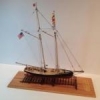-
Posts
575 -
Joined
-
Last visited
About petervisser
- Birthday 07/19/1958
Profile Information
-
Gender
Male
-
Location
Victoria, B.C.
-
Interests
Ship models, travel, history, swimming, reading, flight simming
Recent Profile Visitors
-
 petervisser reacted to a post in a topic:
USS Pennsylvania 1837 by threebs - FINISHED - 1/72 scale - second build in this scale
petervisser reacted to a post in a topic:
USS Pennsylvania 1837 by threebs - FINISHED - 1/72 scale - second build in this scale
-
 petervisser reacted to a post in a topic:
HMS Portland 1770 by Trussben - Portland Scale Ship Co. - 1:48 - 50 gun 4th rate
petervisser reacted to a post in a topic:
HMS Portland 1770 by Trussben - Portland Scale Ship Co. - 1:48 - 50 gun 4th rate
-
 petervisser reacted to a post in a topic:
Roter Löwe 1597 by Ondras71
petervisser reacted to a post in a topic:
Roter Löwe 1597 by Ondras71
-
 petervisser reacted to a post in a topic:
Cutty Sark by uscharin - Sergal - 1:78
petervisser reacted to a post in a topic:
Cutty Sark by uscharin - Sergal - 1:78
-
 petervisser reacted to a post in a topic:
Roter Löwe 1597 by Ondras71
petervisser reacted to a post in a topic:
Roter Löwe 1597 by Ondras71
-
 petervisser reacted to a post in a topic:
Cutty Sark by uscharin - Sergal - 1:78
petervisser reacted to a post in a topic:
Cutty Sark by uscharin - Sergal - 1:78
-
 petervisser reacted to a post in a topic:
Cutty Sark by uscharin - Sergal - 1:78
petervisser reacted to a post in a topic:
Cutty Sark by uscharin - Sergal - 1:78
-
 hof00 reacted to a post in a topic:
Flying Cloud 1851 by hof00 - Mamoli - 1/96 - American clipper
hof00 reacted to a post in a topic:
Flying Cloud 1851 by hof00 - Mamoli - 1/96 - American clipper
-
Quite an array of yards! As with any stage in a model of this type, it's easy to be overwelmed by all the major tasks involved in the model's completion. But you're making great progress, judging by your build log. I look at it as taking bite size pieces and before long another stage of the build is complete! All the best going forward! Peter
- 186 replies
-
- Flying Cloud
- Mamoli
-
(and 1 more)
Tagged with:
-
Always a pleasure to see the added detail you have added to your Cutty Sark Ron. Al;ready looking forward to the next installment. Peter
- 101 replies
-
- Cutty Sark
- Sergal
-
(and 1 more)
Tagged with:
-
Congratulations on your very fine Cutty Sark! A thing of beauty to be sure. Good to see it under glass and well protected from dust and inquisitive fingers.😉
- 42 replies
-
- Cutty Sark
- Sergal
-
(and 1 more)
Tagged with:
-
 uscharin reacted to a post in a topic:
Cutty Sark by uscharin - Sergal - 1:78
uscharin reacted to a post in a topic:
Cutty Sark by uscharin - Sergal - 1:78
-
Just amazing what you have done to add such fine detail to your Cutty Sark! I visited the CS in 1998 before the fire. At the time the model was not really on my radar. I would love to see her again, despite the new arrangements of her display. An elegant example of the evolution of the ship. Your model is also a prime example of what can be accomplished in this amazing hobby! Looking forward to your rigging efforts! All the best, Peter
- 101 replies
-
- Cutty Sark
- Sergal
-
(and 1 more)
Tagged with:
-
 hof00 reacted to a post in a topic:
Cutty Sark by petervisser - Billing Boats - Scale 1:75
hof00 reacted to a post in a topic:
Cutty Sark by petervisser - Billing Boats - Scale 1:75
-
 Jared reacted to a post in a topic:
Flying Fish by Jared - FINISHED - Model Shipways - 1:96
Jared reacted to a post in a topic:
Flying Fish by Jared - FINISHED - Model Shipways - 1:96
-
Truer words have not been said! Your ten points should be included in every model ship kit. Thanks for the insights Jared! Peter
- 431 replies
-
- Flying Fish
- Model Shipways
-
(and 2 more)
Tagged with:
-
Congratulations Jared on your fine model. A real accomplishment for sure! Time to splice that mainbrace! Cheers, Peter
- 431 replies
-
- Flying Fish
- Model Shipways
-
(and 2 more)
Tagged with:
-
An amazing piece of work Rick. A stunning model so far. And the pictures really show off your workmanship. Peter
- 351 replies
-
- Flying Fish
- Model Shipways
-
(and 1 more)
Tagged with:
-
Hi Rob. I find this scale manageable but 1:96 scale would be too challenging for me. I also have a frigate in 1:75 scale which I would love to display next to CS but I’m getting ALOT of pushback from a certain someone about the so called clutter of ship models around the house. Girls….😉
- 207 replies
-
- billing boats
- cutty sark
-
(and 1 more)
Tagged with:
-
Hi Rob. It is the Billing 1:75 kit of a rather old vintage produced in the 70’s I’m guessing. The scale is hiding in the title of the log.😉 Thanks for looking in. Cheers, Peter
- 207 replies
-
- billing boats
- cutty sark
-
(and 1 more)
Tagged with:
-
After tying about 900 clove hitches to complete the ratlines, the model is ready for the last phase of rigging. Phew! I can now begin rigging the braces at last. What with the hot weather here in Victoria, my workshop which is semi-sub ground level is one of the coolest rooms in the house. This has allowed me to work on the model, despite the sunny weather. Here's a photo showing the current status...
- 207 replies
-
- billing boats
- cutty sark
-
(and 1 more)
Tagged with:
-
Like you I am starting to do minor repairs to my model as the project nears the end. What with the complexity and vastness of the rigging it is so easy to snag yards and rigging when concentrating on another aspect of the model. Nice save with your predicament! I am also nearing the stage of installing the braces to the yards and now that I have seen yours, I'm getting antsy to start mine! All the best with the finishing touches, she looks great! Peter
- 431 replies
-
- Flying Fish
- Model Shipways
-
(and 2 more)
Tagged with:
-
Wowser, that is a stunning wheel. An excellent addition to an excellent model. Way to go! Peter
- 101 replies
-
- Cutty Sark
- Sergal
-
(and 1 more)
Tagged with:
-
Looking really good! I think the chain really adds some character to the rigging. Are you adding sails to your model? I'm guessing not, as the yards are attached to the masts already. All the best going forward. Peter
- 431 replies
-
- Flying Fish
- Model Shipways
-
(and 2 more)
Tagged with:
-
Hi HOF. Just saw your latest post and see that you're rigging anchors. You might want to take a look at Prince de Neufchatel by Coyote_6 – Constructo – 1/58 scale - American privateer. I ran across his build log and he has rigged his just recently. I will be following his procedure which appears to me as being the most accurate method. Cheers, Peter
- 186 replies
-
- Flying Cloud
- Mamoli
-
(and 1 more)
Tagged with:
About us
Modelshipworld - Advancing Ship Modeling through Research
SSL Secured
Your security is important for us so this Website is SSL-Secured
NRG Mailing Address
Nautical Research Guild
237 South Lincoln Street
Westmont IL, 60559-1917
Model Ship World ® and the MSW logo are Registered Trademarks, and belong to the Nautical Research Guild (United States Patent and Trademark Office: No. 6,929,264 & No. 6,929,274, registered Dec. 20, 2022)
Helpful Links
About the NRG
If you enjoy building ship models that are historically accurate as well as beautiful, then The Nautical Research Guild (NRG) is just right for you.
The Guild is a non-profit educational organization whose mission is to “Advance Ship Modeling Through Research”. We provide support to our members in their efforts to raise the quality of their model ships.
The Nautical Research Guild has published our world-renowned quarterly magazine, The Nautical Research Journal, since 1955. The pages of the Journal are full of articles by accomplished ship modelers who show you how they create those exquisite details on their models, and by maritime historians who show you the correct details to build. The Journal is available in both print and digital editions. Go to the NRG web site (www.thenrg.org) to download a complimentary digital copy of the Journal. The NRG also publishes plan sets, books and compilations of back issues of the Journal and the former Ships in Scale and Model Ship Builder magazines.








